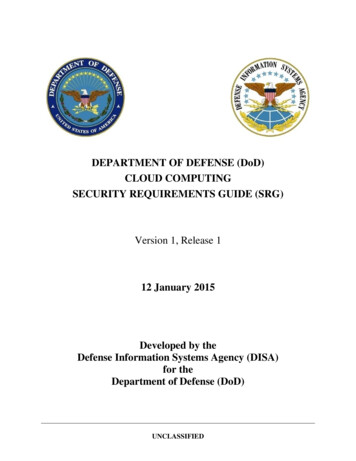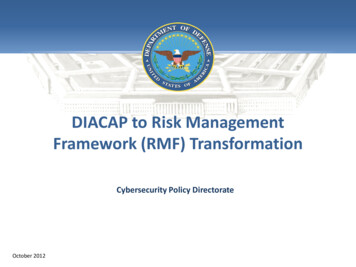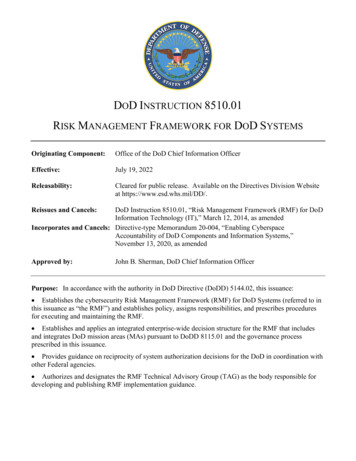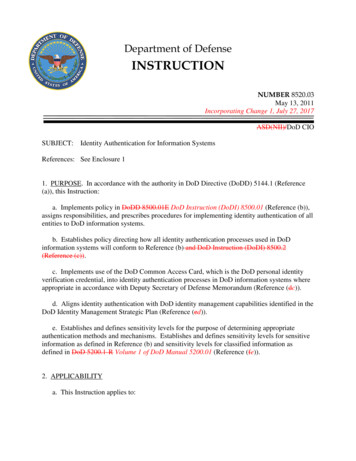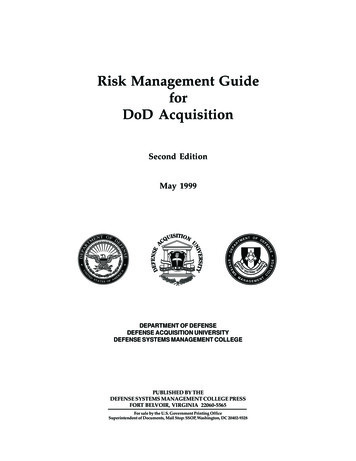
Transcription
Risk Management GuideforDoD AcquisitionSecond EditionMay 1999DEPARTMENT OF DEFENSEDEFENSE ACQUISITION UNIVERSITYDEFENSE SYSTEMS MANAGEMENT COLLEGEPUBLISHED BY THEDEFENSE SYSTEMS MANAGEMENT COLLEGE PRESSFORT BELVOIR, VIRGINIA 22060-5565For sale by the U.S. Government Printing OfficeSuperintendent of Documents, Mail Stop: SSOP, Washington, DC 20402-9328
Please E-Mail comments or recommended changes to:Mcmahon Paul@dsmc.dsm.milBahnmaier Bill@dsmc.dsm.milii
OFFICE OF THE UNDER SECRETARY OF DEFENSE3000 DEFENSE PENTAGONWASHINGTON, DC 20301-3000ACQUISITION ANDTECHNOLOGYRISK MANAGEMENT GUIDEAcquisition reform has changed the way the Department of Defense (DoD) designs,develops, manufactures, and supports systems. Our technical, business, and management approach for acquiring and operating systems has, and continues to, evolve. Forexample, we no longer can rely on military specifications and standards to define andcontrol how our developers design, build, and support our new systems. Today we usecommercial hardware and software, promote open systems architecture, and encouragestreamlining processes, just to name a few of the initiatives that affect the way we dobusiness. At the same time, the Office of the Secretary of Defense (OSD) has reduced thelevel of oversight and review of programs and manufacturers’ plants.While the new acquisition model gives government Program Managers and their contractors broader control and more options than they have enjoyed in the past, it also exposes them to new risks. OSD recognizes that risk is inherent in any acquisition programand considers it essential that Program Managers take appropriate steps to manage andcontrol risks.In late 1996, the Under Secretary of Defense, Acquisition and Technology [USD(A&T)]tasked the Director, Test, Systems Engineering, and Evaluation (DTSE&E) to review DoDrisk management practices and techniques. In response, DTSE&E/Systems Engineeringestablished a Risk Management Working Group that examined the Services, individualacquisition programs, and commercial industry’s treatment of risk. The results of thestudy served as the basis for the risk management section (2.5.2) in the Defense AcquisitionDeskbook. The study also identified the need to update existing risk training material toreflect the new way DoD conducts business.iii
This document is a product of a joint effort among the DTSE&E, the Defense AcquisitionUniversity, and the Defense Systems Management College. It is based on the materialdeveloped by the DoD Risk Management Working Group, included in the DefenseAcquisition Deskbook.Thomas M. CreanPresidentDefense Acquisition UniversityMark D. SchaefferDeputy Director, Test, SystemsEngineering and Evaluation/Systems EngineeringLenn VincentRADM, SC, USNCommandantDefense Systems Management Collegeiv
PREFACEIn December 1995, the Under Secretary of Defense, Acquisition and Technology [USD(A&T)],issued a memorandum entitled Reducing Life Cycle Costs for New and Fielded Systems, in whichhe established the policy and strategy to develop and field affordable weapon systems thatare responsive to user’s needs. One of the foundations of the strategy is the concept of “Costas An Independent Variable” (CAIV), the Department of Defense (DoD) equivalent of commercial best practices. The CAIV concept recognizes that “there are risks to be taken and risksto be avoided. When risks are taken, we will put in place appropriate risk management andcontingency plans.”Other initiatives, such as acquisition streamlining and revision of the DoD 5000 seriesdocuments, were ongoing when the USD(A&T) memorandum was published; each affected program risk. Also at this time, the DoD Inspector General was writing a criticalreport of the Department’s management of risk; the report recommended measures tocontrol risk of acquisition programs. Figure P-1 shows some of the initiatives that impactrisk management.Emphasis onRiskManagementACQUISITION INITIATIVESOPEN SYSTEMSCOST AS AN INDEPENDENT VARIABLE (CAIV)ACQUISITION STREAMLININGCOMMERCIAL ITEMS, HARDWARE AND SOFTWAREMILITARY SPECIFICATIONS AND STANDARDSREDUCED PLANT OVERSIGHTSINGLE PROCESS INITIATIVEREDUCTION IN FUNDINGFigure P-1. DoD Renewed Emphasis on Risk ManagementWith these initiatives as the basis, the USD(A&T) tasked the Director, Test, Systems Engineering, and Evaluation (DTSE&E) to: (1) review DoD risk management practices andtechniques, (2) determine whether new approaches were needed to improve risk management, and (3) report the results to USD(A&T).In response, DTSE&E established a Risk Management Working Group composed of members of the Office of the Secretary of Defense (OSD) staff, representatives of the Services,and members of other DoD agencies involved in systems acquisition. This group reviewedpertinent DoD directives (DoDD) and regulations, examined how the Services managedrisk, studied various examples of risk management by companies in commercial industry, and looked at DoD training and education activity in risk management. The WorkingGroup coordinated with other related efforts in DoD. For example, the Joint AeronauticalCommanders Group Risk Guide was a valuable source of information. The workshops forthe CAIV Flagship programs provided current, real-world examples of Program Managers implementing the CAIV initiative and risk management. Membership of the Workingv
Group included a representative from USD(A&T) Acquisition Program Integration/Program Management (API/PM) who kept members informed on the status of the IntegratedProgram Management Initiative. Other sources of information were the Software Engineering Institute Risk Initiative, the Open Systems Initiative, and Safety and Cost Estimating communities. DTSE&E summarized the findings of the investigation and presented the results to the USD(A&T) in July 1996.The findings and recommendations of the Working Group are summarized below.Commercial Industries Focus of efforts is on getting a product to market at a competitive cost. Companies have either a structured or informal Risk Management process. Evolutionary approaches help avoid or minimize risk. Most approaches employ risk avoidance, early planning, continuous assessment, and problemsolving techniques. Structured approaches, when they exist, are similar to DoD’s approach to Risk Management.The Working Group concluded that industry has no magic formula for Risk Management.The Services The Services differ in their approaches to Risk Management. Each approach has its strengths but no one approach is comprehensive. Consolidation of the strengths of each approach could foster better Risk Management in DoD.The Working Group recommended that the Defense Acquisition Deskbook contain a set of guidelinesfor sound risk management practices, and further, that it contain a set of risk management definitionsthat are comprehensive and useful by all the Components.DoD Policy The risk management policy contained in DoDD 5000.1 is not comprehensive.The Working Group recommended that DoDD 5000.1 be amended to include a more comprehensiveset of risk management policies that focuses on: The relationship between the CAIV concept and Risk Management. Requirement that risk management be prospective (forward looking). Establishment of risk management as a primary management technique to be used by ProgramManagers (PMs).vi
DoD Procedures Risk Management procedures in DoD 5000.2-R are inadequate to fully implement the risk management policy contained in DoDD 5000.1.Procedures are lacking regarding the:–Scope of Risk Management–Purpose of Risk Management––Role of Milestone Decision AuthoritiesRisk Management’s support of CAIV–Risk assessment during Phase 0. Some key procedures may have been lost in transition from DoD 5000.2M to DoD 5000.2-R.The Working Group recommended that procedures in DoD 5000.2-R be expanded, using the DefenseAcquisition Deskbook as the expansion means, in order to provide comprehensive guidance for theimplementation of risk management policy.DoD Risk Management Training Risk management training for the DoD acquisition corps needs to be updated and expanded, andIntegrated Product Team (IPT) and Overarching IPT (OIPT) personnel need to be educated on thenew and expanding role of risk management in DoD systems acquisition. Risk Management knowledge level needs improvement. Education is a key to getting the support of OIPTs and PMs.The Working Group recommended that the Defense Acquisition University (DAU) include training forRisk Management in all functional courses and develop a dedicated risk management course foracquisition corps personnel.DTSE&E briefed the results to the Defense Manufacturing Council, an advisory body to theUSD(A&T), which directed that the recommendations be incorporated in the Defense Acquisition Deskbook. Following that guidance, DTSE&E wrote the risk management portions of theDeskbook.The Risk Deskbook write-up forms the basis for this Guide. The goal of the Risk ManagementGuide is to provide acquisition professionals and program management offices with areference for dealing with system acquisition risks. It has been designed as an aid inclassroom instruction and as a reference for practical applications.This Guide reflects the efforts of many people. Mr. Mark Schaeffer, Deputy Director, Systems Engineering, DTSE&E, who chaired the Risk Management Working Group and Mr.Mike Zsak and Mr. Tom Parry from the DTSE&E, Systems Engineering Support Office,were the driving force behind the risk management initiative. Mr. Paul McMahon andMr. Bill Bahnmaier from the DSMC faculty and Mr. Greg Caruth, Ms. Debbie Gonzalez,SFC Frances Battle, USA, SSgt Gerald Gilchrist, Sr., USAF, from the DSMC Press guidedthe composition of the Guide. Special recognition goes to the Institute for Defense Analyses team composed of Mr. Louis Simpleman, Mr. Ken Evans, Mr. Jim Lloyd, and Mr.Gerald Pike, who compiled the data and wrote major portions of the text.vii
viii
CONTENTSChapter 1 INTRODUCTION . 11.1 Purpose and Scope . 11.2 Organization of the Guide . 11.3 Approach to Risk Management . 21.4 DoD Risk Management Policies and Procedures . 2Chapter 2 RISK AND RISK MANAGEMENT . 32.1 Introduction . 32.2 Overview . 32.3 Risk Management Structure and Definitions . 42.4 Risk Discussion . 62.4.1 Characteristics of Acquisition Risk . 62.4.2 Program Products, Processes, Risk Areas, and Risk Events . 62.5 Risk Planning . 92.5.1 Purpose of Risk Plans . 92.5.2 Risk Planning Process . 92.6 Risk Assessment . 102.6.1 Purpose of Risk Assessments . 102.6.2 Risk Assessment Process . 102.6.3 Timing of Risk Assessments . 112.6.4 Conducting Risk Assessments . 122.7 Risk Handling . 172.7.1 Purpose of Risk Handling . 172.7.2 Risk Handling Process . 172.8 Risk Monitoring . 202.9 Risk Documentation . 21Chapter 3 RISK MANAGEMENT AND DOD ACQUISITION PROCESS . 233.1 Introduction . 233.2 Overview . 233.3 DoD Acquisition Process . 233.4 Characteristics of the Acquisition Process . 243.4.1 Integrated Product and Process Development (IPPD) . 243.4.2 Continuous Risk Management . 243.4.3 Program Stability . 253.4.4 Reduction of Life-Cycle Costs . 253.4.5 Event-Oriented Management . 253.4.6 Modeling and Simulation . 253.5 Risk Management Activities during Acquisition Phases . 263.5.1 Phase 0 . 263.5.2 Subsequent Phases . 273.6 Risk Management and Milestone Decisions . 27ix
3.73.8Risk Management and the Acquisition Strategy . 27Risk Management and CAIV . 28Chapter 4 RISK MANAGEMENT AND PROGRAM MANAGEMENT . 314.1 Introduction . 314.2 Overview . 314.3 Program Manager and Risk Management . 314.3.1 Risk Management is a Program Management Tool . 314.3.2 Risk Management is a Formal Process . 324.3.3 Risk Management is Forward-Looking . 324.3.4 Risk Management is Integral to Integrated Productand Process Development (IPPD) . 334.4 Risk Management Organization in the PMO . 334.4.1 Risk Management Organizational Structure . 334.4.2 Risk Management Responsibilities . 354.5 Contractor Risk Management . 364.5.1 Contractor View of Risk . 364.5.2 Government/Contractor Relationship . 364.6 Risk Management and the Contractual Process . 384.6.1 Risk Management: Pre-Contract Award . 384.6.2 Early Industry Involvement: Industrial Capabilities Review . 384.6.3 Developing the Request for Proposal . 304.6.4 The Offeror’s Proposal . 424.6.5 Basis for Selection . 424.6.6 Source Selection . 434.7 Risk Management: Post-Contract Award . 444.8 Risk Management Reporting and Information System . 454.9 Risk Management Training . 45Chapter 5 RISK MANAGEMENT TECHNIQUES . 495.1 Introduction . 495.2 Overview . 495.3 Risk Planning Techniques . 495.3.1 Description . 495.3.2 Procedures . 505.4 Risk Assessment Techniques . 515.4.1 Product (WBS) Risk Assessment . 515.4.2 Process (DoD 4245.7-M) Risk Assessment . 545.4.3 Program Documentation Evaluation Risk Identification . 565.4.4 Threat and Requirements Risk Assessment . 575.4.5 Cost Risk Assessment . 595.4.6 Quantified Schedule Risk Assessment . 605.4.7 Expert Interviews . 625.4.8 Analogy Comparison/Lessons-Learned Studies . 635.5 Risk Prioritization . 63x
5.65.75.85.95.5.1 Description . 635.5.2 Procedures . 64Risk-Handling Techniques . 665.6.1 General . 665.6.2 Risk Control . 685.6.3 Risk Avoidance . 715.6.4 Risk Assumption . 725.6.5 Risk Transfer . 72Risk Monitoring . 735.7.1 General . 735.7.2 Earned Value Management . 755.7.3 Technical Performance Measurement . 765.7.4 Integrated Planning and Scheduling . 765.7.5 Watch List . 775.7.6 Reports . 785.7.7 Management Indicator System . 79Risk Management Information Systems and Documentation . 825.8.1 Description . 825.8.2 Risk Management Reports . 82Software Risk Management Methodologies . 835.9.1 Software Risk Evaluation (SRE) . 855.9.2 Boehm’s Software Risk Management . 855.9.3 Best Practices Initiative Risk Management Method . 85APPENDIX ADOD RISK MANAGEMENT POLICIES AND PROCEDURES . A-11.DoD 5000.1 Defense Acquisition, March 1996 . A-12.DoD Regulation 5000.2-R. Mandatory Procedures for MajorDefense Acquisition Programs (MDAPs) and Major AutomatedInformation System (MAIS) Acquisition Programs, March 15, 1996 . A-23.DoD Directive (DoDD) 5000.4, OSD Cost AnalysisImprovement Group (CAIG), November 24, 1992 . A-64.DoD 5000.4-M Cost Analysis Guidance and Procedures, December 1992 . A-7APPENDIX BGENERIC RISK MANAGEMENT PLAN .Sample Risk Management Plan .Preface .Sample Format for Risk Management Plan .Sample Risk Management Plan for the XYZ Program (ACAT I, II) .1.0 Introduction .1.1 Purpose .1.2 Program Summary .1.2.1 System Description .1.2.2 Acquisition Strategy .xiB-1B-1B-1B-2B-4B-4B-4B-4B-5B-5
1.2.3 Program Management Approach . B-51.3 Definitions . B-51.3.1 Risk . B-51.3.2 Risk Event . B-51.3.3 Technical Risk . B-61.3.4 Cost Risk . B-61.3.5 Schedule Risk . B-61.3.6 Risk Ratings . B-61.3.7 Independent Risk Assessor . B-71.3.8 Templates and Best Practices . B-71.3.9 Metrics . B-71.3.10 Critical Program Attributes . B-72.0 Risk Management . B-72.1 General Approach and Status . B-72.2 Risk Management Strategy . B-82.3 Organization . B-92.3.1 Risk Management Coordinator . B-92.3.2 Program Integrating Integrated Product Team (PIIPT) . B-102.3.3 PIPTs . B-102.3.4 XYZ Independent Risk Assessors . B-102.3.5 Other Risk Assessment Responsibilities . B-102.3.6 User Participation . B-112.3.7 Risk Training . B-113.0 Risk Planning . B-113.1 Overview . B-113.2 Risk Planning . B-123.2.1 Process . B-123.2.2 Procedures . B-123.3 Risk Assessment . B-133.3.1 Process . B-133.3.2 Procedures . B-143.4 Risk Handling . B-193.4.1 Process . B-193.4.2 Procedures . B-193.5 Risk Monitoring . B-203.5.1 Process . B-203.5.2 Procedures . B-204.0 Risk Management Information System and Documentation . B-214.1 Risk Management Information System (RMIS) . B-214.2 Risk Documentation . B-224.2.1 Risk Assessment Documentation . B-224.2.2 Risk Handling Documentation . B-224.2.3 Risk Monitoring Documentation . B-224.3 Reports . B-22xii
4.3.1 Standard Reports . B-224.3.2 Ad Hoc Reports . B-22Annex A to XYZ Risk Management Plan—Critical Program Attributes . B-23Annex B to XYZ Risk Management Plan—Program Risk Reduction Schedule . B-24Annex C to XYZ Risk Management Plan— Program Metric Examples . B-25Annex D to XYZ Risk Management Plan—Management Information Systemand Documentation . B-271.0 Descript
DoD Risk Management Training Risk management training for the DoD acquisition corps needs to be updated and expanded, and Integrated Product Team (IPT) and Overarching IPT (OIPT) personnel need to be educated on the new and expanding role of risk management in DoD systems acquisition. Risk Management knowledge level needs improvement.

